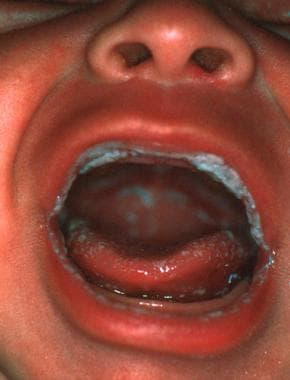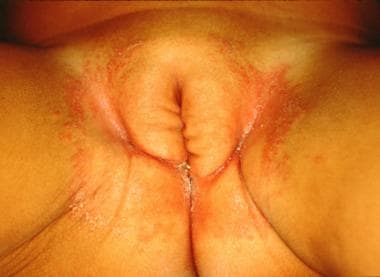Crislip MA, Edwards JE Jr. Candidiasis. Infect Dis Clin North Am. 1989 Mar. 3(1):103-33. [QxMD MEDLINE Link].
Zaoutis TE, Prasad PA, Localio AR, Coffin SE, Bell LM, Walsh TJ, et al. Risk Factors and Predictors for Candidemia in Pediatric Intensive Care Unit Patients: Implications for Prevention. Clin Infect Dis. 2010 Jul 16. [QxMD MEDLINE Link].
Lee JH, Hornik CP, Benjamin DK Jr, Herring AH, Clark RH, Cohen-Wolkowiez M, et al. Risk Factors for Invasive Candidiasis in Infants >1500 g Birth Weight. Pediatr Infect Dis J. 2012 Oct 4. [QxMD MEDLINE Link]. [Full Text].
Green L, Dolen WK. Chronic Candidiasis in Children. Curr Allergy Asthma Rep. 2017 May. 17 (5):31. [QxMD MEDLINE Link].
Steinbach WJ, Roilides E, Berman D, Hoffman JA, Groll AH, Bin-Hussain I, et al. Results From a Prospective, International, Epidemiologic Study of Invasive Candidiasis in Children and Neonates. Pediatr Infect Dis J. 2012 Dec. 31(12):1252-1257. [QxMD MEDLINE Link].
Blyth CC, Palasanthiran P, O'Brien TA. Antifungal therapy in children with invasive fungal infections: a systematic review. Pediatrics. 2007 Apr. 119(4):772-84. [QxMD MEDLINE Link].
Kaufman D, Boyle R, Hazen KC. Twice weekly fluconazole prophylaxis for prevention of invasive Candida infection in high-risk infants of J Pediatr</i>. Aug 2005. 147(2):172-9. [QxMD MEDLINE Link].
Healy CM, Baker CJ, Zaccaria E. Impact of fluconazole prophylaxis on incidence and outcome of invasive candidiasis in a neonatal intensive care unit. J Pediatr. Aug 2005. 147(2):166-71. [QxMD MEDLINE Link].
Uko S, Soghier LM, Vega M, Marsh J, Reinersman GT, Herring L, et al. Targeted short-term fluconazole prophylaxis among very low birth weight and extremely low birth weight infants. Pediatrics. 2006 Apr. 117(4):1243-52. [QxMD MEDLINE Link].
Pappas PG, Kauffman CA, Andes D, Benjamin DK Jr, Calandra TF, Edwards JE Jr, et al. Clinical practice guidelines for the management of candidiasis: 2009 update by the Infectious Diseases Society of America. Clin Infect Dis. 2009 Mar 1. 48(5):503-35. [QxMD MEDLINE Link]. [Full Text].
Manzoni P, Wu C, Tweddle L, Roilides E. Micafungin in premature and non-premature infants: a systematic review of 9 clinical trials. Pediatr Infect Dis J. 2014 Nov. 33 (11):e291-8. [QxMD MEDLINE Link].
Pappas PG, Kauffman CA, Andes DR, Clancy CJ, Marr KA, Ostrosky-Zeichner L, et al. Executive Summary: Clinical Practice Guideline for the Management of Candidiasis: 2016 Update by the Infectious Diseases Society of America. Clin Infect Dis. 2016 Feb 15. 62 (4):409-17. [QxMD MEDLINE Link].
Swift D. New Guideline Calls for Aggressive Treatment of Candidiasis. Medscape Medical News. Available at http://www.medscape.com/viewarticle/856415. December 23, 2015; Accessed: February 8, 2016.
Ericson JE, Kaufman DA, Kicklighter SD, et al. Fluconazole Prophylaxis for the Prevention of Candidiasis in Premature Infants: A Meta-analysis Using Patient-level Data. Clin Infect Dis. 2016 Sep 1. 63 (5):604-10. [QxMD MEDLINE Link].
Kicklighter SD, Springer SC, Cox T, et al. Fluconazole for prophylaxis against candidal rectal colonization in the very low birth weight infant. Pediatrics. Feb 2001. 107(2):293-8. [QxMD MEDLINE Link].
Long SS, Stevenson DK. Reducing Candida infections during neonatal intensive care: management choices, infection control, and fluconazole prophylaxis. J Pediatr. Aug 2005. 147(2):135-41. [QxMD MEDLINE Link].
Manzoni P, Arisio R, Mostert M. Prophylactic fluconazole is effective in preventing fungal colonization and fungal systemic infections in preterm neonates: a single-center, 6-year, retrospective cohort study. Pediatrics. Jan 2006. 117(1):e22-32. [QxMD MEDLINE Link].
Manzoni P, Stolfi I, Pugni L, Decembrino L, Magnani C, Vetrano G, et al. A multicenter, randomized trial of prophylactic fluconazole in preterm neonates. N Engl J Med. 2007 Jun 14. 356(24):2483-95. [QxMD MEDLINE Link].
Mondal RK, Singhi SC, Chakrabarti A, M J. Randomized comparison between fluconazole and itraconazole for the treatment of candidemia in a pediatric intensive care unit: a preliminary study. Pediatr Crit Care Med. 2004 Nov. 5(6):561-5. [QxMD MEDLINE Link].
Feja KN, Wu F, Roberts K, et al. Risk factors for candidemia in critically ill infants: a matched case-control study. J Pediatr. 2005 Aug. 147(2):156-61. [QxMD MEDLINE Link].
Kaufman DA. Aiming for zero: preventing invasive Candida infections in extremely preterm infants. NeoReviews. July, 2011. 12(7):e381-e392.
Alexander BD, Pfaller MA. Contemporary tools for the diagnosis and management of invasive mycoses. Clin Infect Dis. 2006. 43:S15-27.
Bacheller CD, Bernstein JM. Urinary tract infections. Med Clin North Am. 1997 May. 81(3):719-30. [QxMD MEDLINE Link].
Antifungal agents. Benitz WE, Tatro DS, eds. The Pediatric Drug Handbook. 3rd ed. St. Louis, Mo: Mosby; 1975.
Benjamin DK Jr, Stoll BJ, Gantz MG, Walsh MC, Sánchez PJ, Das A, et al. Neonatal Candidiasis: Epidemiology, Risk Factors, and Clinical Judgment. Pediatrics. 2010 Sep 27. [QxMD MEDLINE Link].
Boiko S. Making rash decisions in the diaper area. Pediatr Ann. 2000 Jan. 29(1):50-6. [QxMD MEDLINE Link].
Briggs GG, Freeman RK, Yaffe SJ. Drugs in Pregnancy and Lactation. 3rd ed. Baltimore, Md: Williams & Wilkins; 1990.
Chow BD, Linden JR, Bliss JM. Candida parapsilosis and the neonate: epidemiology, virulence and host defense in a unique patient setting. Expert Rev Anti Infect Ther. 2012 Aug. 10(8):935-46. [QxMD MEDLINE Link]. [Full Text].
Denning DW, Evans EG, Kibbler CC, et al. Fungal nail disease: a guide to good practice (report of a Working Group of the British Society for Medical Mycology). BMJ. 1995 Nov 11. 311(7015):1277-81. [QxMD MEDLINE Link].
Dodds Ashley ES, Lewis R, Lewis JS. Pharmacology of sytemic antifungal agents. Clin Infect Dis. 2006. 43:S28-39.
du Vivier A, McKee PH, eds. Atlas of Clinical Dermatology. Philadelphia, Pa: WB Saunders; 1986.
Elder ME. T-cell immunodeficiencies. Pediatr Clin North Am. 2000 Dec. 47(6):1253-74. [QxMD MEDLINE Link].
Elewski BE. Cutaneous mycoses in children. Br J Dermatol. 1996 Jun. 134 Suppl 46:7-11: discussion 37-8. [QxMD MEDLINE Link].
Fidel PL Jr, Vazquez JA, Sobel JD. Candida glabrata: review of epidemiology, pathogenesis, and clinical disease with comparison to C. albicans. Clin Microbiol Rev. 1999 Jan. 12(1):80-96. [QxMD MEDLINE Link].
Harriet Lane Service, Children's Medical and Surgical Center, Johns Hopkins Hospital. Formulary. Siberry GK, Iannone R, eds. The Harriet Lane Handbook. 15th ed. St Louis, Mo: Mosby; 2000.
Hay RJ. The management of superficial candidiasis. J Am Acad Dermatol. Jun 1999. 40(6 Pt 2):S35-42. [QxMD MEDLINE Link].
Hoppe JE. Treatment of oropharyngeal candidiasis and candidal diaper dermatitis in neonates and infants: review and reappraisal. Pediatr Infect Dis J. Sep 1997. 16(9):885-94. [QxMD MEDLINE Link].
Hsieh E, Smith PB, Jacqz-Aigrain E, Kaguelidou F, Cohen-Wolkowiez M, Manzoni P, et al. Neonatal fungal infections: when to treat?. Early Hum Dev. 2012 May. 88 Suppl 2:S6-S10. [QxMD MEDLINE Link]. [Full Text].
Kauffman CA. The changing landscape of invasive fungal infections: epidemiology, diagnosis, and pharmacologic options. Clin Infect Dis. 2006. 43:S1-2.
Kaufman DA. "Getting to Zero": preventing invasive Candida infections and eliminating infection-related mortality and morbidity in extremely preterm infants. Early Hum Dev. 2012 May. 88 Suppl 2:S45-9. [QxMD MEDLINE Link].
Kaufman DA. Challenging issues in neonatal candidiasis. Curr Med Res Opin. 2010 Jul. 26(7):1769-78. [QxMD MEDLINE Link].
Kaufman DA. Epidemiology and prevention of neonatal candidiasis: fluconazole for all neonates?. Adv Exp Med Biol. 2010. 659:99-119. [QxMD MEDLINE Link].
Kaufman DA. Neonatal candidiasis: clinical manifestations, management, and prevention strategies. J Pediatr. Apr 2010. 156 (Suppl 2):S53-S67.
Legrand F, Lecuit M, Dupont B, Bellaton E, Huerre M, Rohrlich PS. Adjuvant corticosteroid therapy for chronic disseminated candidiasis. Clin Infect Dis. 2008 Mar 1. 46(5):696-702. [QxMD MEDLINE Link].
Leibovitz E. Strategies for the prevention of neonatal candidiasis. Pediatr Neonatol. 2012 Apr. 53(2):83-9. [QxMD MEDLINE Link].
McClelland RS, Richardson BA, Hassan WM, Graham SM, Kiarie J, Baeten JM, et al. Prospective Study of Vaginal Bacterial Flora and Other Risk Factors for Vulvovaginal Candidiasis. J Infect Dis. 2009 Jun 15. 199(12):1883-1890. [QxMD MEDLINE Link].
Odio CM, Araya R, Pinto LE. Caspofungin therapy of neonates with invasive candidiasis. Pediatr Infect Dis J. Dec 2004. 23(12):1093-7. [QxMD MEDLINE Link].
Odom RB. Common superficial fungal infections in immunosuppressed patients. J Am Acad Dermatol. 1994 Sep. 31(3 Pt 2):S56-9. [QxMD MEDLINE Link].
Pappas PG, Kauffman CA, Andes D, Benjamin DK Jr, Calandra TF, Edwards JE Jr, et al. Clinical practice guidelines for the management of candidiasis: 2009 update by the Infectious Diseases Society of America. Clin Infect Dis. 2009 Mar 1. 48(5):503-35. [QxMD MEDLINE Link].
Pfaller MA, Pappas PG, Wingard JR. Invasive fungal pathogens: current epidemiological trends. Clin Infect Dis. 2006. 43:S3-14.
Schwarze R, Penk A, Pittrow L. Administration of fluconazole in children below 1 year of age. Mycoses. Apr 1999. 42(1-2):3-16. [QxMD MEDLINE Link].
Singhi SC, Reddy TC, Chakrabarti A. Candidemia in a pediatric intensive care unit. Pediatr Crit Care Med. Jul 2004. 5(4):369-74. [QxMD MEDLINE Link].
Smith PB, Morgan J, Benjamin JD, et al. Excess costs of hospital care associated with neonatal candidemia. Pediatr Infect Dis J. 2007 Mar. 26(3):197-200. [QxMD MEDLINE Link].
Smith PB, Steinbach WJ, Benjamin DK. Neonatal candidiasis. Infect Dis Clin North Am. Sep 2005. 19(3):603-15. [QxMD MEDLINE Link].
Steinbach WJ. Antifungal agents in children. Pediatr Clin North Am. Jun 2005. 52(3):895-915, viii. [QxMD MEDLINE Link].
Winston DJ, Pakrasi A, Busuttil RW. Prophylactic fluconazole in liver transplant recipients. A randomized, double-blind, placebo-controlled trial. Ann Intern Med. Nov 16 1999. 131(10):729-37. [QxMD MEDLINE Link].
Working Group of the British Society for Medical Mycology. Management of genital candidiasis. BMJ. 1995 May 13. 310(6989):1241-4. [QxMD MEDLINE Link].
Workowski KA, Berman SM. Sexually transmitted diseases treatment guidelines, 2006. MMWR Recomm Rep. Aug 4 2006. 55(RR-11):1-94. [QxMD MEDLINE Link].
Zaoutis TE. Pediatric fungal infections: a conundrum in children. J Pediatr. 2010/04. 156 (Suppl 2):S47-S52.
Zaoutis TE, Heydon K, Localio R, Walsh TJ, Feudtner C. Outcomes attributable to neonatal candidiasis. Clin Infect Dis. 2007 May 1. 44(9):1187-93. [QxMD MEDLINE Link].
Zaoutis TE, Jafri HS, Huang LM, Locatelli F, Barzilai A, Ebell W. A prospective, multicenter study of caspofungin for the treatment of documented Candida or Aspergillus infections in pediatric patients. Pediatrics. 2009 Mar. 123(3):877-84. [QxMD MEDLINE Link].
Tsekoura M, Ioannidou M, Pana ZD, Haidich AB, Antachopoulos C, Iosifidis E, et al. Efficacy and Safety of Echinocandins for the Treatment of Invasive Candidiasis in Children: A Meta-analysis. Pediatr Infect Dis J. 2019 Jan. 38 (1):42-49. [QxMD MEDLINE Link].











